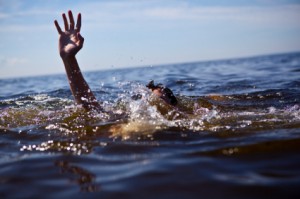As a general rule, do not attempt to initiate water rescue unless you have adequate training and an experienced swimmer. Except for open, shallow waters with uniform floor line or shallow swimming pools, the potential dangers faced during water rescue are too dangerous and too great for any untrained person or poor swimmer to attempt. But if the idea of just standing by and watching someone drown bothers you, then you should consider taking water safety and rescue training course. Attempting water rescue without proper training and adequate skills, you can only end up a victim rather than a rescuer.
Disclaimer: the information posted on this page on water-related accidents is for learning purposes only. To learn about water safety and CPR enrol in St Mark James first aid and CPR classes.
Understanding the drowning process
Drowning is one of the most tragic water-related accidents, especially when it involves young 
The drowning process starts as the person struggles to stay above the water. Then he frantically grasps for air, accompanied by thrashing about. When the person can no longer stay above water and begins to submerge, he breathes in large amounts of air and tries to hold it in. As he does, water may flood the airway. The person experiences series of coughing and swallowing actions, but these desperate actions lead to involuntary swallowing and inhalation of water. As water enters deeper into the airways, it triggers reflex action (called laryngospasm) that completely shuts the airways. This reflex effectively seals the airway that no water ever enters the lungs. Soon after, the person suffers oxygen starvation (hypoxia) and falls unconscious.
Among trained first aiders and rescuers, the term near-drowning is often used instead of drowning. A person who is coughing-out water and shows signs of breathing has nearly drowned but not drowned. However, laypersons may not distinguish these terms. A person who submerged in water has drowned.
Salt-water and fresh-water drowning
Around 10% of all drowning cases die due to true asphyxia or suffocation due to absence of air. Majority of victims die due to final attempts to inhale air that consequently draws water to the lungs; and the eventual loss of laryngospasm after the person becomes unconscious that lead to water freely entering the lungs. The result of water in the body depends on whether the victim has taken in salt or fresh water.
In fresh-water drowning, the major concern is the abnormal heart action called ventricular fibrillation resulting from the accumulation of fluid in the lungs. Meanwhile, in salt-water drowning, hypovolemic shock and hypoxia are the main problems. Excessive salt-water in the system can cause fluid shifts and eventually hypovolemic shock.
Initial treatment for drowning
Although the effect on the body of salt and fresh water may differ, the initial interventions are the same. Obviously, the main goal is to ensure prompt and efficient water rescue. Water rescue training courses will equip you with skills on how to perform this procedure.
After the victim is rescued out of the water, resuscitation measures should follow quickly. Immediate CPR and rescue breathing can help keep the person alive while transporting or waiting for advanced life support measures. Some experts believe that cold-water (below 70 F), near-drowning victims can be effectively resuscitated even after 30 minutes or more following cardiac arrest. Cold water is thought to delay biological death and increase the chances of survival of the victim.
Learn More
To learn more about CPR and how to manage and recognize water related emergencies sign up for St Mark James first aid and CPR classes.
